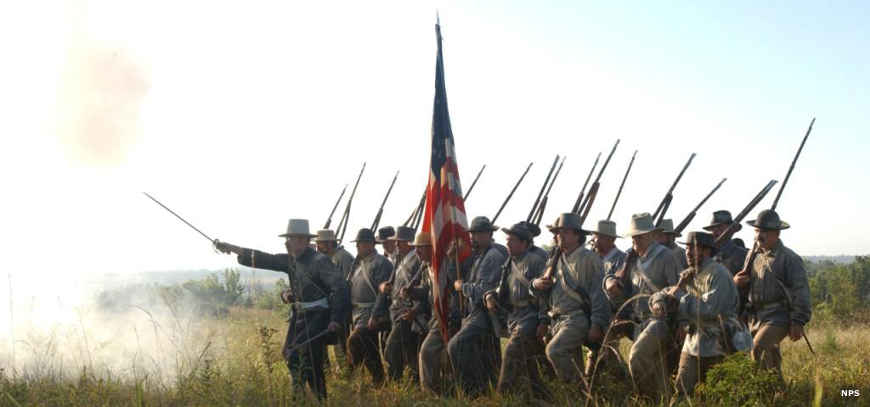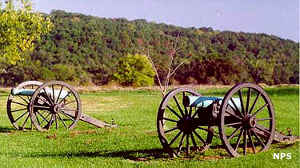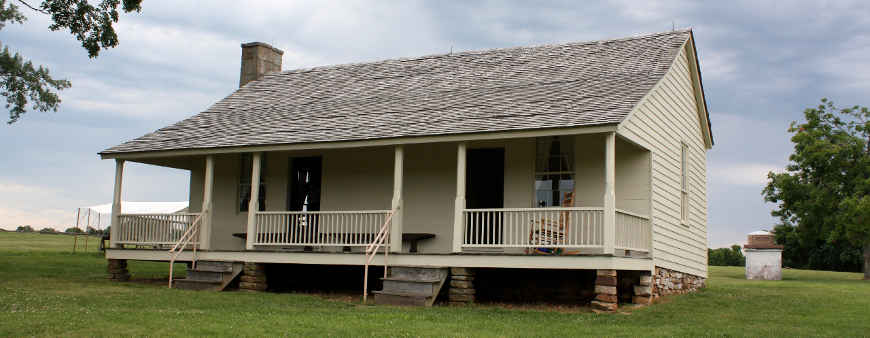Wilson's Creek National Battlefield

A reenactment of the battle

Wilson's Creek National Battlefield is a 1,750-acre property southwest of Springfield, Missouri. Wilson's Creek was the site of the first major Civil War battle fought west of the Mississippi.
It was August, 1861, and the Confederate Army under Brig. General Benjamin McCulloch and the Missouri State Guard under Major General Sterling Price lined up against the Union Army of the West under Brig. General Nathan Lyon. The shooting began around sunrise on August 10 when Union forces attacked Confederate cavalry on high ground. The Confederates retreated and the Union occupied the top of the hill. The Confederates counterattacked three times that morning but never broke through the Union lines. The Union lost their two primary commanders and by noon, a Major Samuel Sturgis was in charge. When the third Confederate attack backed off, Sturgis realized his men were exhausted and low on ammunition so he ordered a retreat.
That ended the battle that day: the Confederates were too disorganized and too poorly equipped to chase after and follow up on their victory. So they won the battle but they lost most of Missouri and the state stayed in the Union, despite a governor who was removed from office for fighting alongside the Confederates.
The Confederate Army of the West moved south after the battle, heading back to Arkansas where they had more support and the supply lines were much shorter. By early 1862 the Union has chased all formal Confederate opposition from Missouri but the southwest corner of the state harbored a lot of resentment and that gave birth to guerrilla groups like Quantrill's Raiders and Bloody Bill Anderson.
After the Battle of Wilson's Creek General Price became a commissioned Major General in the Confederate Army, based primarily in northwestern Arkansas. He led his troops in battles in Arkansas and Mississippi until 1864. In the fall of 1864 Price returned to Missouri in an attempt to influence the upcoming federal elections where a win for Abraham Lincoln meant a loss for the Confederacy. For one month Price and his men marched across Missouri and into Kansas, Oklahoma and Texas before returning to Arkansas with their tails between their legs. Price began the expedition with about 12,000 soldiers and by the time it was over, he'd lost 6,000 of them. In his sweep across Missouri and into Kansas he'd collected up nearly all the guerrillas, bushwhackers and other active Southern sympathizers in the area. Most of them did not survive to reach the end of the journey.
Of those who did survive, many were part of Shelby's Iron Brigade, a group of Missouri recruits distinguished by their fierceness in battle and their ruthless treatment of any civilians they came across along the way. When the war ended, most of the Iron Brigade went to Mexico rather than surrender. In Mexico they offered their services to Emperor Maximilian but he declined. He did grant them a large chunk of free land for an American colony and many settled there peacefully. Others were part of Quantrill's Raiders, and that group metamorphosed into several smaller groups around the time Quantrill was killed by Union forces. Bloody Bill Anderson broke away with his men and after he was killed later in 1864, Archie Clement took over. Among that gang were the famous James brothers, Frank and Jesse.
Price's Raid was the last major incursion of Confederate forces into Missouri. The Missouri-bred guerrillas, however, became famous gunslingers and bank robbers, active until most were killed or imprisoned over the next 20 years.
Wilson's Creek National Battlefield is open daily year-round except closed on Thanksgiving, Christmas and New Year's Days. The Visitor Center is generally open from 9 am to 5 pm, open a bit earlier in summer. The park offers a 5-mile interpretive auto route that is also open year-round, generally the same hours as the Visitor Center except earlier and later in the summer. The entry fee is $7 per adult 16-and-over, to a max of $15 per vehicle (subject to change). If the Visitor Center is closed but the Tour Gate open, entry is free.

The Ray House was a Confederate field hospital during the battle
Lower photo courtesy of Wikipedia userid TimothyMN, CCA-by-SA 3.0 License
Other photos and map courtesy of the National Park Service